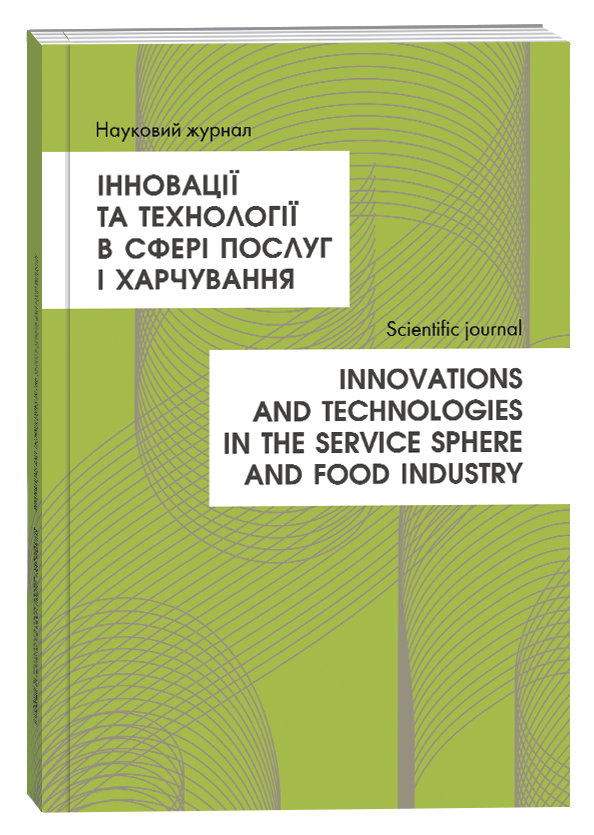AMARANTH IN PÂTÉ FORMULATIONS: INNOVATIVE APPROACHES TO NUTRITIONAL ENHANCEMENT AND SHELF-LIFE EXTENSION
Abstract
In today’s context of increasing attention to the quality and safety of food products, the development of meat products that combine high nutritional value with consumer convenience is of particular relevance. Liver pâtés enjoy significant popularity due to their rich content of proteins, vitamins, and minerals, making them an important component of a balanced diet. However, traditional formulations of these products often contain a high proportion of fat, which limits their appeal among individuals who prefer a healthy lifestyle. This article focuses on improving the consumer properties of liver pâtés through the use of amaranth-based raw materials and examines the impact of this factor on the product’s shelf life. The aim of the study was to investigate the effect of amaranth flakes on the nutritional value and stability of liver–plant pâtés, which enables optimization of the formulation, improvement of the product’s functional and technological characteristics, and development of a product with enhanced biological value and extended shelf life. The study employed general scientific methods, including analysis, synthesis, comparison, systematization, as well as experimental modeling of technological processes. A promising direction for formulation improvement is the incorporation of plant-based ingredients, particularly amaranth flakes, which are a source of easily digestible protein, dietary fiber, minerals, and natural antioxidants. They contribute to strengthening the immune system, normalizing metabolism, increasing nutritional value, improving organoleptic characteristics, and extending storage life by slowing oxidative processes. The plant component significantly influences the flavor, aroma, and appearance of liver-plant pâtés. Amaranth flakes help balance the product’s fat content and serve as a natural preservative, while onions enhance its aromatic profile. At the same time, the effect of amaranth flakes on the quality, nutritional value, and stability of liver pâtés during storage remains insufficiently studied. Therefore, investigating these aspects is important for the development of modern technologies in the meat processing industry. The results obtained indicate that the addition of plant components has a positive effect on pâté quality, although the degree of this influence depends on their concentration in the formulation.
References
Paula Manuela de Castro Cardoso Pereira, Ana Filipa dos Reis Baltazar Vicente. Meat nutritional composition and nutritive role in the human diet. Meat Science. 2013. Volume 93(3). P. 586–592. DOI: https://doi.org/10.1016/j.meatsci.2012.09.018
Brenda Rodas, Ricardo Bressan. The oil, fatty acid and squalene content of varieties of raw and processed grain amaranthi. Archivos Latinoamericanos de Nutrición (ALAN). 2009. Volume 59. № 1. Р. 82–87.
Пасічний В. М., Топчій О. А., Ткач Н. І., Герудчук А. М. Розробка технології паштету печінкового підвищеної харчової цінності. Науковий вісник Полтавського університету економіки і торгівлі. 2019. № 1 (91). С. 47–53.
De Carli C., Moraes-Lovison M., Pinho S.C. Production, physicochemical stability of quer cetin-loaded nanoemulsions and evaluation of antioxidant activity in spreadable chicken pâtés. LWT. 2018. Vol. 98. P. 154–161. DOI: https://doi.org/10.1016/j.lwt.2018.08.037
Gradinarska-Ivanova D., Momchilova M., Yordanov D., Petrova T. Inulin and lentil flour as fat replacers in meat-vegetable pate – a mixture design approach. Carpathian journal of food science and technology. 2019. Vol. 11. № 3. P. 5–14. DOI: https://doi.org/10.34302/cptjfst/2019.11.3.1
Calderón-Oliver M., & López-Hernández L. H. Food vegetable and fruit waste used in meat products. Food Reviews International. 2022. Volume 38(4). Р. 628–654. DOI: https://doi.org/10.1080/87559129.2020.1740732
Estévez, M.; Cava, R. Lipid and protein oxidation, the release of iron from heme molecule and colour deterioration during refrigerated storage of liver pâté. Meat Science. 2004. Volume 68. Р. 551–558.
Estévez, Morcuende, Ramı́rez, Ventanas, & Cava. Extensively reared Iberian pigs versus intensively reared white pigs for the manufacture of liver pâté. Meat Science. 2004. Volume 67. Issue 3. P. 453–461.
Москалюк О. Є., Гащук О.І . Розроблення паштетів з використанням фітокомплексу злакових культур «CHOICE». Наукові праці Національного університету харчових технологій. 2017. Т. 23. № 4. С. 238–243.
Таблиця калорійності. Tablycjakalorijnosti.com.ua. URL: https://www.tablycjakalorijnosti.com.ua/stravy/korop-varenyy (дата звернення: 27.07.2025)
Paula Manuela de Castro Cardoso Pereira, Ana Filipa dos Reis Baltazar Vicente (2013). Meat nutritional composition and nutritive role in the human diet. Meat Science. Volume 93, Issue 3, pp. 586–592. DOI: https://doi.org/10.1016/j.meatsci.2012.09.018
Brenda Rodas, Ricardo Bressan (2009). The oil, fatty acid and squalene content of varieties of raw and processed grain amaranthi. Archivos Latinoamericanos de Nutrición (ALAN), V 59, № 1, pp. 82–87.
Pasichnyy, V. M., Topchiy, O. A., Tkach, N. I., & Herudchuk, A. M. (2019). Rozrobka tekhnolohiyi pashtetu pechinkovoho pidvyshchenoyi kharchovoyi tsinnosti [Development of technology of liver pâté with increased nutritional value]. Naukovyy visnyk Poltavskoho universytetu ekonomiky i torgivli, (1(91)), pp. 47–53. (in Ukrainian)
De Carli C., Moraes-Lovison M., Pinho S.C. (2018). Production, physicochemical stability of quercetin-loaded nanoemulsions and evaluation of antioxidant activity in spreadable chicken pâtés. LWT. Vol. 98. pp. 154–161. DOI: https://doi.org/10.1016/j.lwt.2018.08.037
Gradinarska-Ivanova D., Momchilova M.M., Yordanov D., Petrova T. (2019). Inulin and lentil flour as fat replacers in meat-vegetable pate – a mixture design approach. Carpathian journal of food science and technology. Vol. 11. N 3. pp. 5–14. DOI: https://doi.org/10.34302/cptjfst/2019.11.3.1
Calderón-Oliver M., & López-Hernández L. H. (2022). Food vegetable and fruit waste used in meat products. Food Reviews International, V. 38(4), pp. 628–654. DOI: https://doi.org/10.1080/87559129.2020.1740732.
Estévez, M.; Cava, R. (2004). Lipid and protein oxidation, the release of iron from heme molecule and colour deterioration during refrigerated storage of liver pâté. Meat Science. V. 68, pp. 551–558.
Estévez, Morcuende, Ramı́rez, Ventanas, & Cava (2004). Extensively reared Iberian pigs versus intensively reared white pigs for the manufacture of liver pâté. Meat Science. Volume 67, Issue 3, pp. 453–461.
Moskaluk, O. Ye., & Hashchuk, O. I. (2017). Rozroblennya pashtetiv z vykorystannyam fitokompleksu zlakovykh kulʹtur «CHOICE» [Development of pâtés using a phytocomplex of cereal crops "CHOICE"]. Naukovi pratsi Natsionalʹnoho universytetu kharchovykh tekhnolohiy, 23(4), pp. 238–243. (in Ukrainian)
Tablycjakalorijnosti.com.ua. Available at: https://www.tablycjakalorijnosti.com.ua/stravy/korop-varenyy (accessed 27.07.2025)



